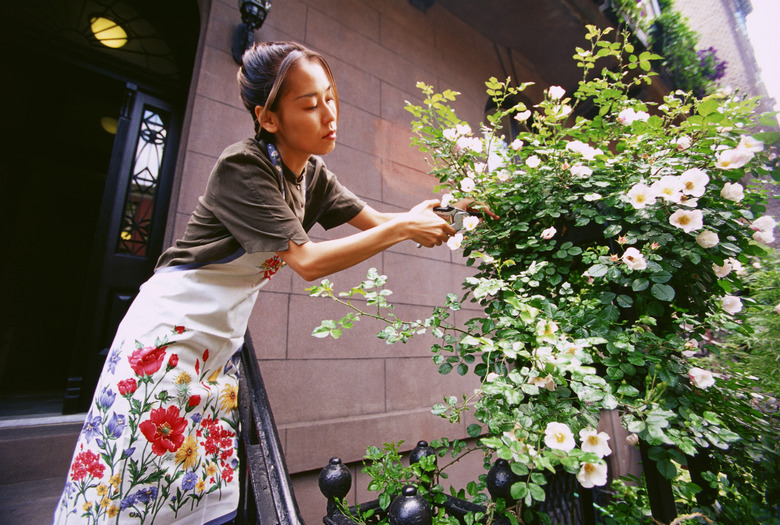What Is Powdery White Stuff On My Rose Bush Leaves?
Roses (Rosa spp.) range in size from miniature plants less than 8 inches tall to tree-climbing varieties that reach more than 50 foot long. Most roses fall somewhere in between, including the commonly planted shrub rose (Rosa glauca), a 6- to 8-foot-tall plant that thrives in U.S. Department of Agriculture plant hardiness zones 2 through 8. Roses offer colorful, fragrant blooms, but powdery mildew disease can make the naturally beautiful plants look unsightly.
Powdery Mildew Symptoms
Step 1
Powdery mildew, the most common rose bush disease, earned its name because the fungal pathogens cause a white powdery growth to coat the leaves, buds, flowers and stems. Early signs of powdery mildew include small, blister-like lesions appearing on the leaves. As the disease progresses, the infected leaf surfaces develop small, circular white spots. The spots enlarge and merge to form a large mat of white mildew. The powdery mildew pathogens kill plant cells in the leaves, resulting in curled, distorted or crinkled foliage that typically falls from the shrub prematurely. The leaves can't undergo photosynthesis while covered with mildew, which causes the infected rose plant to lose vigor.
- range in size from miniature plants less than 8 inches tall to tree-climbing varieties that reach more than 50 foot long.
- The powdery mildew pathogens kill plant cells in the leaves, resulting in curled, distorted or crinkled foliage that typically falls from the shrub prematurely.
Disease Causes
Step 1
The white powdery coating on rose bush leaves contains thousands of microscopic fungal spores (Sphaerotheca pannosa var. rosae) that invade the plant tissue to feed and reproduce. Small, dark fruiting structures allow the fungi to survive the winter on rose bushes and fallen plant debris. Powdery mildew primarily occurs in the spring when warm days are followed by cool, damp evenings. Because this disease thrives in cloudy conditions and high humidity levels, the symptoms typically disappear once the hot summer weather arrives. Powdery mildew fungal spores easily spread to new rose bushes through wind gusts.
Preventing Powdery Mildew
Step 1
Roses prefer fully sunny locations that receive at least six hours of direct sunlight every day. Planting bushes in full sun also helps prevent powdery mildew because direct sunlight and hot temperatures more than 95 degrees Fahrenheit usually kill the fungal spores. Cleaning up garden debris prevents the fungal pathogens from overwintering near your shrub, while applying a thick layer of organic mulch early in spring can help cover up any spores that overwintered in the soil. Prune off and destroy infected foliage, and selectively prune out dense interiors to increase the amount of airflow throughout the entire plant. Two or three times a week, spray your rose bush with a hard stream of water from the garden hose to wash off the spores that haven't yet invaded the plant tissue.
- The white powdery coating on rose bush leaves contains thousands of microscopic fungal spores (Sphaerotheca pannosa var.
- Two or three times a week, spray your rose bush with a hard stream of water from the garden hose to wash off the spores that haven't yet invaded the plant tissue.
Treating Powdery Mildew
Step 1
Although control is primarily achieved through cultural practices, severe powdery mildew infections might require a little chemical help. Although no cure exists as of July 2013, you can often prevent and control the spread of powdery mildew disease by using a simple homemade solution. Simply mix 3 teaspoons of baking soda and 2 tablespoons of a lightweight horticultural oil for each gallon of water. Spray your bush until the foliage glistens with moisture. Reapply the solution every seven days for the best results.
References
- American Rose Society: Powdery Mildew: An Ounce of Prevention
- Pacific Northwest Plant Disease Management Handbook: Rose (Rosa Sp.) and Hybrids- Powdery Mildew
- Missouri Botanical Garden: Rosa Glauca
- Clemson Cooperative Extension: Growing Roses
- UC IPM Online Powdery Mildew on Ornamentals
- Galveston Country Master Gardeners: What is Powdery Mildew on Roses? Can It Be Treated?
